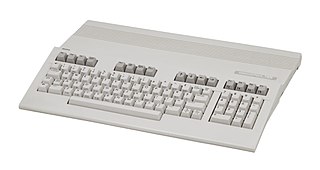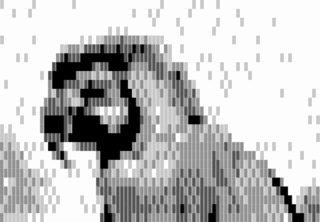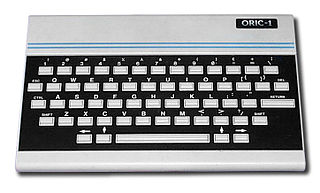Related Research Articles
Applesoft BASIC is a dialect of Microsoft BASIC, developed by Marc McDonald and Ric Weiland, supplied with Apple II computers. It supersedes Integer BASIC and is the BASIC in ROM in all Apple II series computers after the original Apple II model. It is also referred to as FP BASIC because of the Apple DOS command FP used to invoke it, instead of INT for Integer BASIC.

The RadioShack TRS-80 Color Computer, later marketed as the Tandy Color Computer, is a series of home computers developed and sold by Tandy Corporation. Despite sharing a name with the earlier TRS-80, the Color Computer is a completely different system and a radical departure in design based on the Motorola 6809E processor rather than the Zilog Z80 of earlier models.

The Atari 8-bit computers, formally launched as the Atari Home Computer System, are a series of 8-bit home computers introduced by Atari, Inc., in 1979 with the Atari 400 and Atari 800. The architecture is designed around the MOS Technology 6502 CPU and three custom coprocessors which provide support for sprites, smooth multidirectional scrolling, four channels of audio, and other features. The graphics and sound are more advanced than most of its contemporaries, and video games are a key part of the software library. The 1980 first-person space combat simulator Star Raiders is considered the platform's killer app.

The Commodore 128, also known as the C128, C-128, or C= 128, is the last 8-bit home computer that was commercially released by Commodore Business Machines (CBM). Introduced in January 1985 at the CES in Las Vegas, it appeared three years after its predecessor, the Commodore 64, the bestselling computer of the 1980s. Approximately 2.5 million C128s were sold during its four year production run.

The Bally Astrocade is a second-generation home video game console and simple computer system designed by a team at Midway, at that time the videogame division of Bally. It was originally announced as the "Bally Home Library Computer" in October 1977 and initially made available for mail order in December 1977. But due to production delays, the units were first released to stores in April 1978 and its branding changed to "Bally Professional Arcade". It was marketed only for a limited time before Bally decided to exit the market. The rights were later picked up by a third-party company, who re-released it and sold it until around 1984. The Astrocade is particularly notable for its very powerful graphics capabilities for the time of release, and for the difficulty in accessing those capabilities.

Locomotive Basic is a proprietary dialect of the BASIC programming language written by Locomotive Software on the Amstrad CPC and the later Locomotive BASIC-2 as a GEM application on the Amstrad PC1512 and 1640. It was the main descendant of Mallard BASIC, the interpreter for CP/M supplied with the Amstrad PCW.
Sinclair BASIC is a dialect of the programming language BASIC used in the 8-bit home computers from Sinclair Research, Timex Sinclair and Amstrad. The Sinclair BASIC interpreter was written by Nine Tiles Networks Ltd.

The Color Graphics Adapter (CGA), originally also called the Color/Graphics Adapter or IBM Color/Graphics Monitor Adapter, introduced in 1981, was IBM's first color graphics card for the IBM PC and established a de facto computer display standard.

The VTech Laser 200 is an 8-bit home computer from 1983, also sold as the Salora Fellow, the Seltron 200 in Hungary and Italy, the Smart-Alec Jr. by Dynasty Computer Corporation in Dallas, Texas for the USA, the Texet TX8000A, and the Dick Smith VZ 200 and the VTech VZ 200.

TI BASIC is an ANSI-compliant interpreter for the BASIC programming language built into the 1979 Texas Instruments TI-99/4 home computer and its improved 1981 version, the TI-99/4A.

Vilnius BASIC, sometimes known as BK BASIC, is a dialect of the BASIC programming language running on the Elektronika BK-0010-01/BK-0011M and UKNC computers. It was developed at Vilnius University, located in Lithuania which was a republic of the Soviet Union at the time.

The VIC-1211 Super Expander is a cartridge for the VIC-20 home computer. It was designed to provide several extensions to the BASIC interpreter on the computer, mostly to help with programming graphics and sound. It also provided 3 kB of extra RAM. The cartridge was created by Commodore Business Machines (CBM) and released in 1981.

Simons' BASIC is an extension to BASIC 2.0 for the Commodore 64 home computer. Written by British programmer David Simons in 1983, who was 16 years old at the time, it was distributed by Commodore as a cartridge.
Super Expander 64 is a cartridge-based extension to the built in BASIC interpreter of Commodore 64 home computer. It was published by Commodore Business Machines in 1983. The built-in BASIC of the C64 was adapted from the PET and VIC 20, and the language does not have direct support for the system's sound and graphics hardware. Super Expander 64 adds functions for drawing graphics, using sprites, reading joysticks, playing audio, and other features.

The DAI personal computer is an early home computer from the Belgian company Data Applications International. The DAI came to market in 1980. It provided many pioneering features such as high resolution color graphics, a maths co-processor, and a pre-compiling BASIC interpreter. However, it never became a commercial success.
The Panasonic JR-200 was a simple, relatively early (1983), 8-bit home computer with a chiclet keyboard somewhat similar to the VTech Laser 200. It's part of the JR Series.
ReGIS, short for Remote Graphic Instruction Set, is a vector graphics markup language developed by Digital Equipment Corporation (DEC) for later models of their famous VT series of computer terminals. ReGIS supports rudimentary vector graphics consisting of lines, circular arcs, and similar shapes. Terminals supporting ReGIS generally allow graphics and text to be mixed on-screen, which makes the construction of graphs and charts relatively easy.
The Matsushita JR series was a line of microcomputers produced by Matsushita Electric Industrial during the 1980s. Based on the success of the Sharp MZ and NEC PC-8000 series, it was an attempt by Matsushita to enter the personal computer market.

Text-based semigraphics, pseudographics, or character graphics is a primitive method used in early text mode video hardware to emulate raster graphics without having to implement the logic for such a display mode.

Oric was a brand of home computers sold in the 1980s by Tangerine Computer Systems. Tangerine was based in the United Kingdom and sold their computers primarily in Europe. All computers in the Oric line were based on the MOS Technology 6502A microprocessor.
References
- ↑ "JR-100". 計算機室. May 28, 2017.
- 1 2 "Operating Instructions - Personal Computer JR-100U" – via Internet Archive.
- ↑ "OLD-COMPUTERS.COM : The Museum MATSUSHITA National JR 100". www.old-computers.com.
- ↑ "Creative Computing Magazine (May. 1983) Volume 09 Number 05". May 10, 1983 – via Internet Archive.